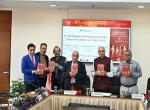On July 10, the Vivekananda International Foundation (VIF) organized a talk on ‘‘Varna, Ashrama and the Indic Religious Tradition” by Prof. Arvind Sharma, Birks Professor of Comparative Religion in the School of Religious Studies at McGill University in Montreal, Canada and formerly part of the Indian Administrative Service (IAS). This was the third talk in the series of lectures and discussions on Indic religious traditions.
Dr. Arvind Gupta, Director, VIF, delivered the opening remarks, in which he briefly talked about the misconceptions surrounding the words Varna and Ashrama in the minds of the uninformed. He also talked about developing a systematic understanding of Indic religious traditions. In his keynote address, Prof. Sharma highlighted that the word caste is very ambiguous. The word caste, which doesn’t have an Indic origin, has been indiscriminately used to refer to two distinctive sociological concepts, namelyJati and Varna. To understand the term Varna, one must refer to the Purusha Sukta, a hymn from the Rigveda dedicated to Purusha, the cosmic being. The concept of Varna proposes the division of Hindu society into four groups, namely Brahmins, Kshatriyas, Vaishyas and Shudras. The 12th verse of the Purusha Sukta (hymn) refers to these four Varnas together for the first time in Rigveda. According to this hymn, the universe was created through the sacrifice of the cosmic being, Purusha. The parts of the universe, such as heaven, earth and the objects found in the universe, came into being from various body parts of the Purusha. Brahmins emerged from the mouth of the Purusha; the Rajanyas or Kshatriyas emerged from his arms; the Vaishyas from the thighs; and the Shudras from the feet.
The next question that arises is the question of hierarchy among the four Varnas. The Brahmin is considered the highest, and the rest enjoy a position in the hierarchy in the order in which they are enumerated. This hierarchy is not based on power, because if that had been the case, the Kshatriyas would have been on top. It is also not based on wealth; otherwise, the Vaishyas would have been on top. It is also not based on the service that the Shudras provide. The hierarchy is based on ritual and moral authority. The western account of the Varna system often highlights the privileges that the Brahmins enjoy. It is true that the Brahmins enjoy some privileges like precedence in society and freedom from capital punishment, etc. But the word privilege in modern society is associated with wealth and power. It creates the mistaken impression that the Brahmins have greater access to political and economic power compared to others. In reality, the Brahmins are placed in a privileged position in the Varna system because they are not supposed to enjoy wealth and power.
Prof. Sharma explained the hierarchy of the Varnas, which is interpreted on the basis of the sanctity of the body parts of the Purusha from which they emerged. The head being considered superior to the arms, arms superior to the thighs, and feet being associated with the lowest caste, but it is important to realise that it is not the only interpretation available to us. The Shudras claimed that because they emerged from the feet of the Purusha, who is also identified as Vishnu, the Shudras are of commendable birth. Even the holy river Ganga emerged from Vishnu’s feet. In an inscription from 1368 CE, the Nayakas rulers of southern India claimed superiority over other Varnas based on this interpretation.
In the Brihadaranyaka Upanishad (800 BCE), it is stated that in the beginning, this world was only Brahma and it was not developed. A superior form was created, the Kshatriyas, but it was still not developed. The Vaishya was created to further develop the world, which was followed by the Shudras. In this narrative, each succeeding form is described as better than the previous one. The Kshatriya is better than the Brahmans, the Vaishyas are better than the Kshatriyas and the Shudras are better than the Vaishyas.
The conceptual framework of the Varna system is not confined to Hinduism, but it is also employed with suitable changes and adjustments in other religious traditions of Indian origin, such as Buddhism, Jainism and Sikhism. But there is a difference in the way the Varna system is held in these Indic religions. In Hinduism, the Varna system has been exclusively connected with the doctrine of Karma. Whereas in the case of other traditions, there is no doctrinal commitment to Karma as a feature of governance, but they have caste distinction.
There were no restrictions based on caste on joining the Buddhist Sangha. But the Buddhist had accepted the Varna system, and according to the Buddhist, Buddha or Bodhisattvas are only born as a Brahman or a Kshatriya, depending upon which of these is considered superior at the time of his birth. The Buddhist literature suggests that the Buddha of the future, Maitreya, would be born as a Brahman. In Jainism, Mahavir, the last Tirthankara, is known to be a Brahman. There is also discussion in Jainism regarding a true Brahman in a well-known Jain text, the Uttaradhyayana Sutra. In Sikhism, Bhagat Ravidas, Bhagat Kabir, Bhagat Guru Nanak Dev ji, and the gurus are considered Brahmans in Sikh lore.
In agreement with Prof. Arvind Sharma, Prof. Shashi Prabha Kumar further talked about the Varna system as described in the Vedic texts. The etymology of the term Varna was discussed. In the Vedic traditions, anybody could choose his/her occupation, and Varna was a choice of occupation. During the Vedic period, people from the same family could belong to different Varnas based on the occupation they chose based on their own aptitude and interest. In the Vedic system, manual work was not considered inferior.
Prof. Santosh Kumar Shukla talked about the English word caste, which has Spanish and Portuguese origins. He reiterated that the word caste does not represent Jati. The session was then opened for discussion, followed by closing remarks by Dr. Arvind Gupta.






Post new comment